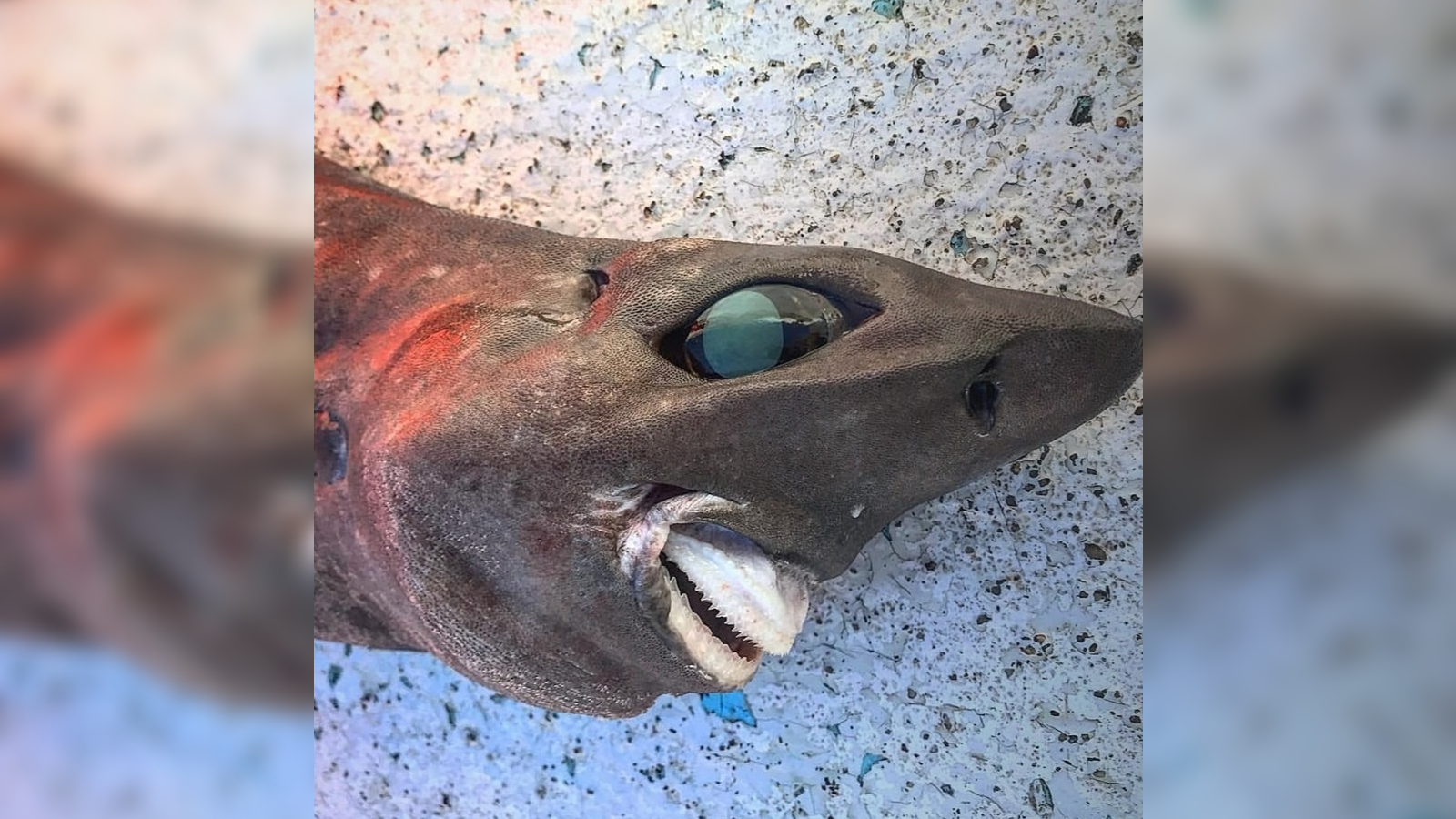Mysterious 'nightmare' shark with unnerving human-like smile dragged up from the deep sea
Experts are unsure exactly which species the creepy creature belongs to.

A bizarre deep-sea shark with bulging eyes and an unnerving, human-like smile was recently dragged up from the depths off the coast of Australia. Shark experts are uncertain exactly which species the creepy-looking creature might belong to, adding to the mystery surrounding the unusual specimen.
A deep-sea angler, who goes by the online name Trapman Bermagui, reeled in the mysterious shark from a depth of around 2,130 feet (650 meters) off the coast of New South Wales in Australia. The fisher later shared a snap of the deep-sea specimen on Sept. 12 on Facebook. The image shows off the dead shark's rough sandpaper-like skin, large pointed snout, large bulging eyes and exposed pearly whites.
The shark’s unusual features quickly caught the attention of other Facebook users, who were either amazed or terrified by the creature. One commenter wrote that the specimen was "the stuff of nightmares," while another wrote that the creature's "evil smile" gave them "major creeps." Other people joked about the animal's appearance, speculating that the shark was wearing "false teeth" or that it was smiling after finally having its braces removed.
Commenters also speculated about which species the shark belonged to. The most common guess was that the specimen was a cookiecutter shark (Isistius brasiliensis), which is named for the distinctive bite marks it leaves on larger animals. Other guesses included a goblin shark (Mitsukurina owstoni) or a species of lantern shark (Etmopteridae).
However, Trapman Bermagui disagreed with the online commenters. "Totally not a cookiecutter," the fisher told Newsweek. "It's a rough skin shark, also known as a species of endeavor dogfish."
Endeavor dogfish (Centrophorus moluccensis) are a type of gulper shark, a group of deep-sea sharks found throughout the world, according to the Shark Research Institute.
But some shark experts were unconvinced by the fisher's identification.
Sign up for the Live Science daily newsletter now
Get the world’s most fascinating discoveries delivered straight to your inbox.
"Looks to me like a deepwater kitefin shark (Dalatias licha), which are known in the waters off Australia," Christopher Lowe, director of the Shark Lab at California State University, Long Beach, told Newsweek. Although, it is hard to tell for sure without being able to see the entire specimen, he added.
Dean Grubbs, a marine biologist and shark expert at Florida State University, offered up a different conclusion. Grubbs suspected that the dead shark was a roughskin dogfish (Centroscymnus owstonii), a type of sleeper shark from the same family as Greenland sharks (Somniosus microcephalus), according to Newsweek.
It is also possible that the shark could belong to a never-before-seen species, Lowe said. "We discover new species of deepwater shark all the time and many look very similar to each other."
However, other experts believe that Trapman Bermagui may have been spot on after all.
"It's a gulper shark," Brit Finucci, a fisheries scientist at the National Institute of Water and Atmospheric Research in New Zealand who specializes in deep-sea sharks, told Live Science in an email. However, it is unclear exactly which species in this group it belongs to, she added.
Charlie Huveneers, a shark scientist at Flinders University in Australia, told Live Science that he agreed with Finucci's identification and that the animal was most likely a gulper shark.
"In the past, gulper sharks were targeted by fisheries for their liver oil in New South Wales," Finucci said. Most gulper sharks are "very sensitive to overexploitation from fishing" and as a result, "some species are now highly threatened and protected in Australia," she added.
Originally published on Live Science.

Harry is a U.K.-based senior staff writer at Live Science. He studied marine biology at the University of Exeter before training to become a journalist. He covers a wide range of topics including space exploration, planetary science, space weather, climate change, animal behavior and paleontology. His recent work on the solar maximum won "best space submission" at the 2024 Aerospace Media Awards and was shortlisted in the "top scoop" category at the NCTJ Awards for Excellence in 2023. He also writes Live Science's weekly Earth from space series.










